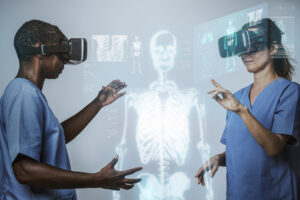In recent years, Artificial Intelligence (AI) has emerged as a transformative force in medical diagnostics, driving innovation and enhancing patient care. This article explores the latest research insights into how AI is revolutionizing diagnostic practices in healthcare. We will delve into AI technologies, their applications, recent advancements, and their impact on the future of medicine.
1. Understanding AI in Medical Diagnostics
1.1. Definition and Scope
Artificial Intelligence refers to the simulation of human intelligence processes by machines, particularly computer systems. In the context of medical diagnostics, AI encompasses a range of technologies, including machine learning, deep learning, and natural language processing, that enable computers to analyze complex medical data, recognize patterns, and make predictions.
1.2. Key Technologies
- Machine Learning (ML): A subset of AI where algorithms improve automatically through experience. In diagnostics, ML models analyze historical patient data to predict disease outcomes.
- Deep Learning (DL): A subset of ML that uses neural networks with multiple layers to extract features from data. DL is particularly effective in image analysis, such as interpreting medical scans.
- Natural Language Processing (NLP): Enables machines to understand and interpret human language. NLP is used to analyze patient records and extract relevant information.
2. Applications of AI in Medical Diagnostics
2.1. Imaging and Radiology
AI has made significant strides in the field of medical imaging. Advanced algorithms now assist radiologists in interpreting X-rays, MRIs, and CT scans. AI systems can detect anomalies such as tumors or fractures with high accuracy and speed.
2.1.1. Recent Research
Recent studies highlight AI’s ability to outperform human radiologists in certain tasks. For instance, a study published in Nature Medicine demonstrated that an AI system could identify breast cancer with greater precision than radiologists, reducing false positives and negatives.
2.2. Pathology
In pathology, AI assists in analyzing tissue samples and identifying pathological conditions. AI algorithms can process high-resolution images of biopsies to detect cancerous cells or other abnormalities.
2.2.1. Recent Research
A 2023 study in The Lancet Oncology revealed that AI could accurately classify different types of cancer from pathology slides, offering potential for personalized treatment plans and improved patient outcomes.
2.3. Genomics
AI plays a crucial role in genomics by analyzing genetic data to identify mutations associated with diseases. AI algorithms help in interpreting complex genomic sequences and predicting disease risk based on genetic predispositions.
2.3.1. Recent Research
Research published in Nature Genetics in 2024 demonstrated AI’s capability to predict genetic disorders with high accuracy, assisting in early diagnosis and preventive care.
3. Advantages of AI in Diagnostics
3.1. Improved Accuracy and Speed
AI algorithms can process vast amounts of data quickly and accurately, reducing diagnostic errors and accelerating the time to diagnosis. This efficiency is particularly valuable in emergency situations where timely intervention is critical.
3.2. Enhanced Personalization
AI facilitates personalized medicine by analyzing individual patient data to tailor diagnostic and treatment strategies. This approach ensures that patients receive care that is specifically suited to their unique health conditions and genetic profiles.
3.3. Cost Reduction
AI can help reduce healthcare costs by minimizing the need for repetitive tests and optimizing diagnostic workflows. Automation of routine tasks allows healthcare professionals to focus on more complex cases, improving overall efficiency.
4. Challenges and Considerations
4.1. Data Privacy and Security
The use of AI in medical diagnostics involves handling sensitive patient data. Ensuring data privacy and security is paramount to maintaining patient trust and compliance with regulations such as the Health Insurance Portability and Accountability Act (HIPAA).
4.2. Ethical Implications
AI’s role in diagnostics raises ethical concerns regarding the potential for bias in algorithms and the implications of automated decision-making. Ongoing research and regulatory oversight are necessary to address these concerns and ensure equitable healthcare delivery.
4.3. Integration into Clinical Practice
Integrating AI systems into existing clinical workflows requires careful planning and training. Healthcare providers must be equipped with the skills to utilize AI tools effectively while maintaining the human element in patient care.
5. Future Directions
5.1. Integration with Other Technologies
The future of AI in diagnostics lies in its integration with other technologies, such as wearable devices and telemedicine platforms. Combining AI with these innovations can enhance remote diagnostics and patient monitoring.
5.2. Continuous Learning and Adaptation
AI systems must continuously learn and adapt to new medical knowledge and data. Ongoing research is focused on developing AI models that can evolve and improve over time, ensuring they remain relevant and effective.
5.3. Collaboration and Regulation
Collaboration between AI developers, healthcare professionals, and regulatory bodies is essential to advance AI in diagnostics. Establishing clear guidelines and standards will facilitate the responsible use of AI and maximize its benefits for patient care.
Conclusion
AI is revolutionizing medical diagnostics by enhancing accuracy, speed, and personalization. Recent research underscores the potential of AI to transform healthcare practices, making diagnostics more efficient and effective. As AI technology continues to evolve, its integration into clinical practice will likely become more seamless, paving the way for a new era of medical innovation. Ensuring data privacy, addressing ethical concerns, and fostering collaboration will be crucial in harnessing AI’s full potential while providing high-quality patient care.




